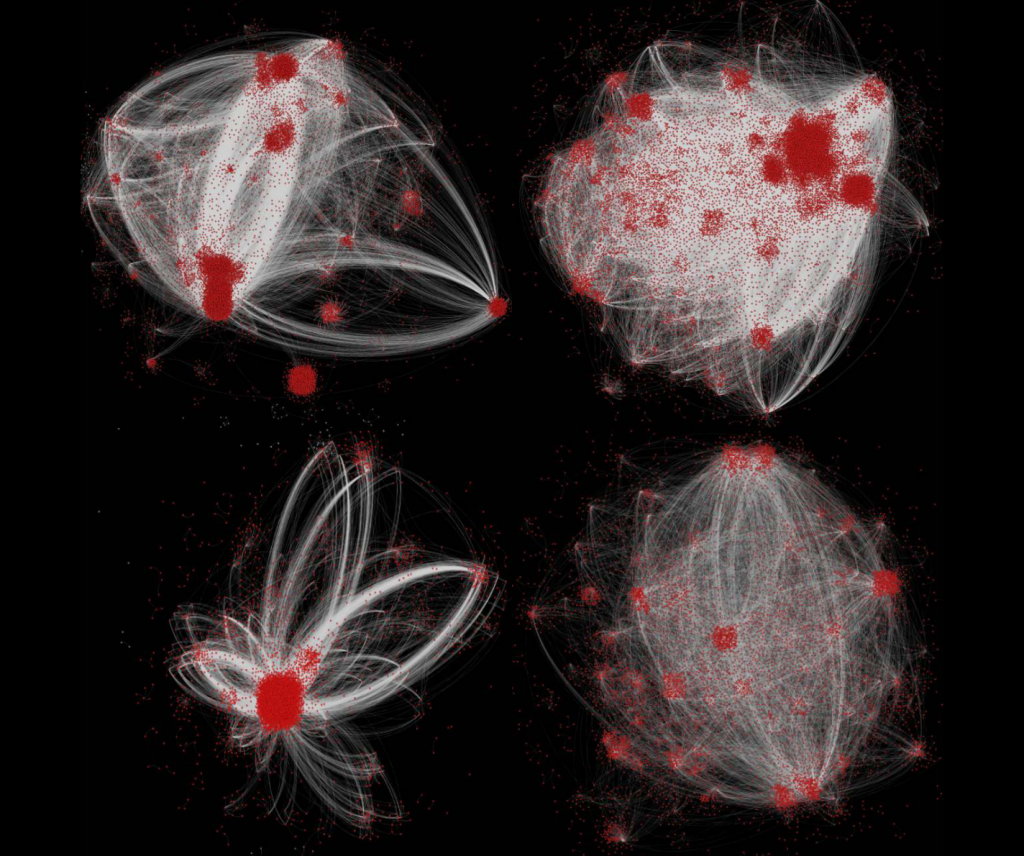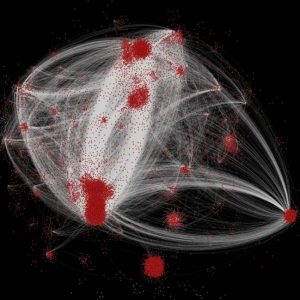06 October 2021, Iris Proff

Twitter users (red) using #Anonymous and their interactions (white) over four months. © Davide Beraldo
Who or what is Anonymous? The internet phenomenon is notoriously hard to grasp and define. Anyone can use the name of Anonymous for their own causes and often, these causes are contradictory. For instance, during many social upheavals, one and the same government was both supported and defamed under the name of Anonymous. When asked to describe what Anonymous is all about, its supporters tend to use poetic paradoxes or tautologies, such as: “Anonymous is nobody. Anonymous is nothing. Anonymous is an idea. Ideas can’t be killed.”
Connecting unlikely groups: the case of Anonymous

“What defines Anonymous is not its content, but its packaging”, says Davide Beraldo, a researcher at the Media Studies department of the University of Amsterdam who explored digital social movements during his PhD. Anonymous’ “packaging” mainly consists in a set of symbols, such as the Guy Fawkes mask which first appeared in the graphic novel V for Vendetta as a symbol of protest against an oppressive regime. These symbols have the power to bind together people who identify themselves as protestors of some sort – and have little in common otherwise.
“Expressions such as ’Anonymous’, ‘Occupy’, ‘BlackLiveMatters’, but in retrospect even ‘feminism’, ‘communism’ and ‘liberalism’, work as containers for sometimes slightly different, sometimes plainly contradictory positions”, says Beraldo. However, for most social movements, a core, binding element exists – be it the fight against racism or for women’s rights. This is not true for Anonymous. Only due to the “materiality of digital communication” can such a paradoxical and anti-essentialist phenomenon exist, Beraldo believes.
Mutating memes
The digital world is the perfect breeding ground for memes. In the original sense of the word, as described in 1976 by evolutionary biologist Richard Dawkins, a meme is the cultural equivalent of a biological gene: A single idea which reproduces as it spreads from one mind to another and mutates along the way. Digital media gives anyone the power to spread, reinvent and adapt memes – be it symbols, sentences, or pictures – at high speed and with high reach.
This allows the meaning of memes to morph much more rapidly than it could in the analogue world. It makes it harder to identify if someone is speaking in a genuine, ironic, or sarcastic manner. And it creates ambiguity on many different levels – a concept that Beraldo is especially interested in. All communication is ambiguous. However, in the digital world “the distinction between what is real and fake, what is the ‘authentic’ meaning of something, or the ‘original’ intention of an actor, all become even more blurred,” Beraldo says. The inherently paradoxical phenomenon Anonymous is the best example for this.
Zooming into data maps

Does digital media change the idea of “meaning” altogether? This is one of the grand questions Beraldo’s research is after. He approaches it by combining qualitative methods with computational tools.
One of his favorite methods is visual network analysis: Here, an algorithm is used to scrape tweets or Facebook posts and arrange them into a network, which then becomes a map to navigate huge datasets. By zooming in at different points of this map the researcher can interpret the data. “Computational tools allow for the complexity reduction necessary to apply interpretative methods at larger scale, while interpretative methods allow to provide depth and context to mathematical elaborations”, says Beraldo.
On the flip side: fragmenting communities
As Beraldo’s analyses of Anonymous show, digital communication can connect highly diverse groups of people. On the flip side, it can as well pull people apart and fragment communities, mainly through the use of personalization algorithms on social media platforms. The Algorithms Exposed initiative (ALEX) of the Media Studies department, which Beraldo is part of, investigates how these algorithms affect digital communities.
Personalization algorithms learn the interests and preferences of internet users and present them with individualized content matching their preferences. This might create filter bubbles and fuel political polarization, as different parts of society are confronted with different sources of information that tend to confirm what they already believe in.
The harmful potential of personalization algorithms first became obvious after the 2016 US elections, in what has come to be known as the Cambridge Analytica Scandal. Ever since, we know that political elections might be vulnerable to manipulation through micro-targeting – individualized political ads shown to specific demographic groups. When paired with misinformation, micro-targeting becomes a real danger to democratic processes.
Micro-targeting in the Dutch elections

This problem is not confined to the US. Also in European elections, micro-targeting plays an ever more important role, even though it does not draw the same level of public attention. To investigate the role of micro-targeting in the 2021 Dutch national elections, the ALEX initiative partnered up with the University of Amsterdam’s Communication Science department, I&O Research and the Dutch newspaper Volkskrant. The researchers collected data straight from the news feed of 600 Dutch Facebook users, along with survey data about their political beliefs and voting behavior.
The first goal of this research, which is still ongoing, is to find out which impact micro-targeting by different political parties had on people’s voting behavior. On a meta-level, Beraldo explains, the research is also concerned with the methods and politics of micro-targeting: What logic do personalization algorithms follow? Which obstacles hamper independent research on this topic? And crucially, are Facebook’s initiatives to ensure transparency truly transparent? “The overall goal of the ALEX initiative is to redistribute the value of data”, says Beraldo. “If data stays with the platform, then its value will stay with the platform, too. And with those who own it.”
Connecting and disconnecting
Connecting individuals through ambiguous concepts and disconnecting communities through alternative realities – digital media does both. A paradox in itself? “It is important to avoid a deterministic perspective on this, and keep in mind that contrasting tendencies – coming together and fragmentation – can co-exist”, says Beraldo. “It is an important research goal to assess when one or the other prevails, and under which circumstances this can harm society.”